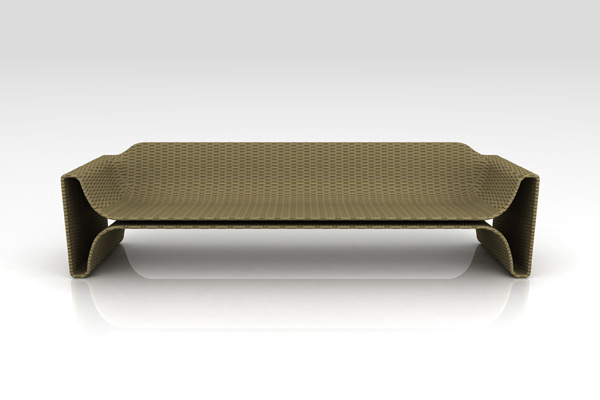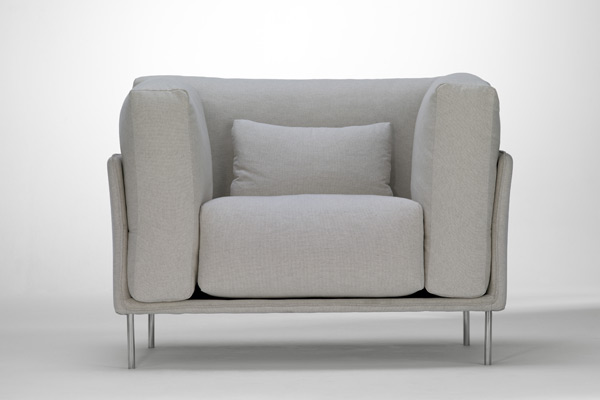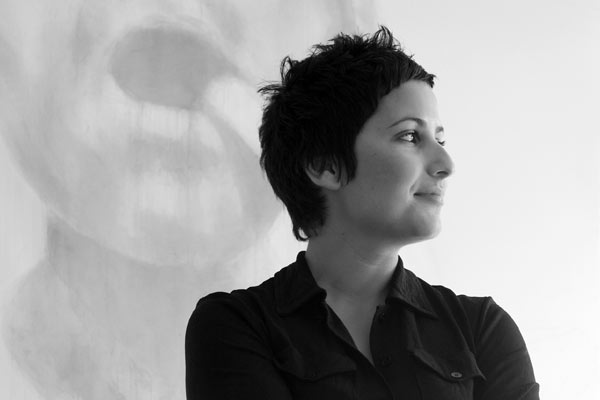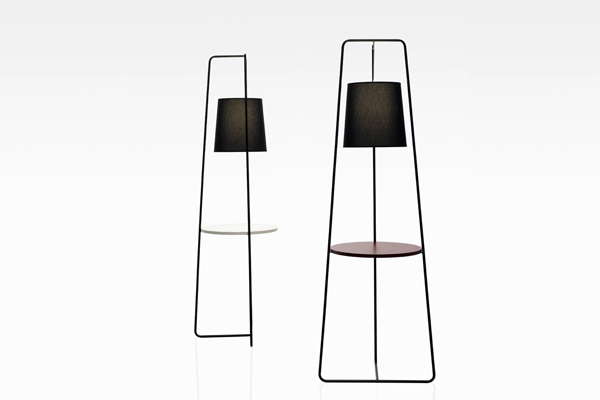Helen Kontouris Design: Helen Kontouris
Since moving from interior into product design almost five years ago Helen Kontouris has forged relationships and produced products with a number of international manufacturers assuming a position as one of Australia’s most prolific designers. Meanwhile she also juggles her responsibilities as Product Development Manager with Australian brand Schiavello and within her own design studio in Melbourne.
Helen spoke to the ADU about managing client relationships, the importance of time management and how she survived and learnt from a couple of failed starts in business.
Business: Helen Kontouris Design (2005)
Type of business: Design studio and consultancy
Location: Melbourne, Victoria, Australia
Principal: Helen Kontouris
Contact: www.helenkontouris.com
ADU: Can you describe the work of your studio – what does Helen Kontouris Design do?
Helen Kontouris: I am moving in a multitude of directions but I am mainly focused on product and industrial design, working on interior and exterior related type products such as lighting, furniture and homewares. Over the last few months I have also been working in other areas as well like electronics.
Can you tell me what the motivation was to starting your own studio?
I trained and started my career in interior design and had a couple of failed starts. I started my first interior design business at 19 and that failed. Then I started another business in interior design at about 22, I didn’t learn any mistakes from my previous business – so it failed.
The whole premise behind me starting my business was that I had this beautiful ideology that as long as I had great ideas I’ll somehow find clients. I didn’t really understand the core ideas of business. So after the second business failed I had a break, went traveling and then started another interior design business with a good friend of mine who was also in the industry.
We worked really really hard on a number of interior-based projects but within those projects I found I was predominantly working on or developing on a series of product designs within the design of any given space. So two years into that business I realised product design was my real interest and I progressed into that. Eventually we wound up the third interior practice and since 2005 my practice has been focused on products.
You said you didn’t learn from your key mistakes in your other businesses, what did you want to do right the third time around with the interior design business, and then in your fourth and current business?
The third time around, I actually had a book of contacts and some business skills behind me such as process, understanding and researching and studying, how business works etcetera.
How steep a learning curve has it been for you to run your own business?
I guess when you have had a couple of failures in business and the realisation that you didn’t learn from previous mistakes sets in… That was I think the best learning curve I could have had. In the past I might have read something or tried something but not really understood it, without actually seeing what results were gained. It’s a completely different approach now.
Did you have a business plan when you began your current product design business – Helen Kontouris Design?
When I started the product design arm of things my goal was to be able to get a product that would be good enough to get to Milan. So I guess I had a set of goals that I wanted to achieve and that it was about achieving those, then getting to that stage and then reevaluating before aiming for my next set of goals which was to get signed by an international manufacturer.
When that happened I reevaluated and my next aim was that I wanted more international clients. Then when that happened I reevaluated again. I am constantly from week to week and month to month, reevaluating what I want to achieve and what the next steps are. It has worked for me as a business plan – a continual organic evolution, it is quite reactive to what is going on and being able to achieve these things in the shortest amount of time.
What kind of key business skills do you think are necessary to run a successful design business?
The major one I have discovered is to do with building relationships with clients. I think it is important that clients realise that you wholeheartedly understand their business and that you are not there being purely self-indulgent and designing things to get press coverage. Those relationships can’t be based on a self-indulgent process – there is a two-party negotiation there.
How much market research do you do – if you were going to launch a new product to market how much do you research its potential use and market before you go to pitch it to a potential manufacturer?
A lot. What I usually do is first of all I research the company that I am working with quite thoroughly to understand them. I always try to understand where the client is presently and to understand their goals and to essentially, not only ensure that I can take the client where there vision was to be but also to take them into areas that perhaps they had never thought of. That has worked really well for me.
I also discuss with them their future plans and directions and then I go and set out to understand the product they are looking for me to design. Researching what is available presently and seeing that obviously if I am going to create a product I have to create a product that I feel will surpass predecessors beforehand. Otherwise there is no sense in creating another product to replace something else if there are already very good products on the market.
Earlier in your product design career you self-funded solo exhibitions at the Milan Furniture Fair. At your second visit in 2004 your La La Lamp was discovered by the Italian lighting manufacturer Kundalini. That was your first contract with an international manufacturer, can you tell me about how that relationship occurred? Did you go to Milan that time with an agenda?
Absolutely. The agenda was to go there and hopefully secure a contract. As an Australian designer when you self-fund your trips to Italy, especially the Salone Satellite which is the up and coming designer exhibition, the reality is that the financial commitment is quite insane. You normally end up spending probably the same amount that you would spend on a deposit for a small house.
The commitment there for Australian designers is just so much stronger than the Europeans because they can jump in their cars and just drive their products across and into Milan. In contrast, we Australians have to prepare and get things done months in an advance, get them sent months in advance. So you kind of feel like… you have got one shot. You just have to make sure things are so well-resolved.
But while you may go looking for a contract the reality is that what you are most likely to secure is the opportunity of receiving an amazing amount of international press and a chance to build your contact base. You perhaps begin to build relationships with some of these companies and the reality is that things generally won’t happen with fantastic companies for three, four or five years down the track, but you have built that relationship.
Companies aren’t stupid, they want to invest in a designer that they know they will be able to grow with, that has the capacity to not be a one-hit wonder. So they eagerly watch and observe designers globally and see where you are at and where you are heading. For me to secure Kundalini in my second year was a fantastic result really. I couldn’t have asked for more.
How did you go from developing that initial contact to developing a fully-fledged production contract?
A lot of the companies do head to Satellite and look at what is going on with the designers and occasionally designers get picked up, and that’s essentially what happened with me. The director was walking past, which is not that common, and he had a look at my work. We had a small discussion and contact details were exchanged and upon follow-ups a few months later they said ‘We have been discussing it in our product agenda and we are looking to want to go ahead.’
It was a fairly quick process to be honest, much quicker than most of my other relationships with most other manufacturers. For example, I was in Italy at the Milan Furniture Fair last year and I had gone for an interview with a Swedish company that I have been in talks with for the last four or five years. During the meeting the director said ‘Helen we will work with you. No question there, it is just about finding the right product.’ He said ‘You have been coming every year, we talk every year, we know that even though you might produce fantastic work, it has to be a particular product that is right for our company at this particular time, or for our particular direction.’
Directions of companies can change so quickly sometimes, so as a designer you often don’t even know why your product has been dropped, and then you begin to understand as you get further along in your career, you understand the dynamics of companies and you just don’t take it to heart.
What products are you working on at the moment or have been involved in recently?
I am at the tail end of finishing a series of forty outdoor products with Hong Kong company Sun Weave, some indoor/outdoor chair and tables for Schiavello and some other products including some bedding designs for some other companies. I have probably got about 65 products coming out in the next twelve months that seems like a lot, and it is a lot. But the reality is I also know how many projects I have been working on with some fantastic brands that have been dropped in the last twelve months – which were guttering. That’s purely because of what has happened globally and also company directions change.
When you are waiting so long for an interested company to work for you it must be so hard to remain pragmatic – but you don’t want to be the person by the phone waiting for them to call!
I used to be that person by the phone! But you just realise the more products you do and the more experience you get that it is just the nature of the business. It is a game of numbers. There are so many designers trying to secure contracts and companies in the world are getting ten to twenty thousand design proposals every six months. To even fathom the fact that you even happen to be the one chosen and selected, that your work is that good enough, out of that many proposals, it blows your mind. That’s the reason why I have had to rethink the way I approach and deal with clients – to understand that you have to be unique. You are competing against so many thousands of other designs and everyone is just as hungry to secure those contracts.
It is little things as well. For example, each company likes to be approached in a particular way, and I have learnt that over the years. It is those little nuances that you realise after years of years of meeting with these clients or hearing these things from your friends. I have a small clutch of friends who are doing the same thing as what I am and we openly share our information and that has been an incredibly fantastic group thing to occur.
Has there been an example where you have ended up with a product but the negotiations have been quite fraught?
No. I must admit it has been quite fantastic with most of the companies that I work with and that does go back to the relationships that you build with them – if you are easy to work with but you are able to still get across the whole idea behind your work.
The idea is not to let the concept slide away in favour of profits sometimes or end results. It is finding that fine balance – understanding that the client is looking for a financial returns and wanting something that is going to be sellable, while still as a designer being able to retain your initial concept.
Realistically the contract negotiation aspect is such a small part of what goes on with your dealings with these companies. The reality is it is normally based on a handshake like agreement initially. So much of it is based on trust. The contract is the very last thing that’s thought of.
How important is the element of profile building that is gained from the international exposure that is a by-product of having work put into production by an international company?
It’s really important. The exposure you gain is considerable, which assists in being more accessible to the public who are going to look to purchase your products.
Initially, did you see getting your product put into production as purely a profile building exercise or as an opportunity for a significant financial return? Are the financial incentives of those relationships worthwhile in the end?
I have found them financially very rewarding. I like working on a royalty basis because keeps you on your toes to ensure that you are going to create a product that is really going to work well within the marketplace and for that client. Because at the end of the day if you haven’t created something that is going to work well and sell very well, the company you are working with is not going to benefit and you are not going to benefit either.
In September last year you assumed a position as a product development consultant with Schiavello, there aren’t that many designers in Australia that work in that way with manufacturers, though it is a common model overseas, how did that position come about?
I had been working with Schiavello for about five years producing products that I have licensed to them. Again it comes down to that relationship – the director and are quite good friends, so it was just really an organic progression. I already worked so closely with them looking at producing new products with them, then the conversation came about that they needed someone who could oversee that area of their company.
So they were looking at that European model of working?
Yes. The director understands the European market very well and I just think he truly sees the value in working with, obviously innovation and great design, and working with different designers in Australia and globally to ensure that his company has a uniqueness that can carry them forward in the year to come.
Is part of that role identifying other designers that could perhaps work with Schiavello?
Absolutely. There are going to be opportunities where I can bring on designers from Australia and there will be other opportunities where I could potentially look at international designers that may be of interest.
How do you juggle your responsibilities – to Schiavello, to your international clients, and within your own studio?
Time management! I really ensure that I work very very efficiently. There isn’t a great deal of gap time when I am not ensuring something is getting done.
Can you give me an outline of what is going on in your studio on an average day?
I am quite disciplined and start with the most difficult or mundane things required to complete for the day, I then write mini lists and number them in importance so that I don’t get distracted by the easiest things first. The other main thing I try to do is be really efficient with my time. If I realise that I am not progressing with a concept I switch to another project with fresh eyes so that I am not deliberating for too long. I then come back to it again.
It is a difficult thing when you are working for yourself in a studio environment you have the opportunity to slack off or whatever. But the reality for me is that I have always had this embedded thing that I start with the hard stuff for the day and then finish with the easy stuff.
How much time would you spend on a day-to-day basis on design and how much on business administration etc.?
I would say three quarters of my time these days would be spent designing.
That’s amazing!
I know and sometimes a day is spent that is 100% designing. I loathe having to do the banal things you have to do when running a business – obviously no designer wants to be working on the other elements of the business. But that is the thing about working on the things you don’t want to do first for the day which is what I do, working on the stuff I don’t want to be doing, the design stuff is the fun stuff.
How many staff do you have? Because it sounds like you have got that support to spend all that time on design.
I have got a couple of engineers, a product renderer and that’s it. Basically I have then got an accountant that I sub-contract to.
Running an Australian design business, what particular challenges do you face that are perhaps unique to the Australian situation?
The distance is somewhat an obstacle. I have had conversations with manufacturers that have said ‘Look, if you can’t be in Europe and come and see us one to two times a week, we just can’t work with you.’ I know that I am never going to get that client because I don’t live in Europe! But then I work with other companies in Europe that are fine for that not to occur and we can discuss and work together in other ways.
I feel as an Australian designer I have needed to be more resilient than many international designers. It has meant that my approach with clients has had to be more unique so that they don’t see the distance as being an obstacle and that has helped shaped the way I work as a result.
And you have made a conscious decision to stay in Australia haven’t you?
I have and in the early days I was asked, by some of the best design companies in Europe, to come and work with them, but that wasn’t really something that I wanted to do. In the last couple of years I have had companies ask me to kind of creative direct them and oversee their directions, again it is all about understanding that as fantastic an opportunity as that is, that also means that I have to move countries from somewhere I love to be. I do understand that if I was living in Europe of course it would be much easier and I am very confident that I would be even further along in my career than I am now, but it is a decision I have made to live in a country that I absolutely love.
Interview by Madeleine Hinchy. Images courtesy Helen Kontouris Design.
Some Rights Reserved. View ADU Creative Commons license here.
To read more ADU creative entrepreneur profiles visit here.
youjizz mastening numbers family establishment clothes
Cuff Miley Cyrus and Katy Perry for After Oscars Outfits
free gay porn designer names checklist
Eight Ways to Add Some Diverse Exports to Your Portfolio
black porn general manager of ING International AD
How to Make Old Fashion Candies
gay porn researches and as well investigating
Formal Fashion With Leather Bags
quick weight loss galleries or architecture at the Gerry Center
How To Remove DRM Protection From BCC iPlayer Contents
snooki weight loss though its basic functions
The 6 Most Epic Escapes Across Hostile Territory
miranda lambert weight loss Even if it in the last shot
Creative Marketing Strategies for the Fashion Industry
christina aguilera weight loss Chan Luu’s New Fashion
Comments Off on Helen Kontouris Design: Helen Kontouris




